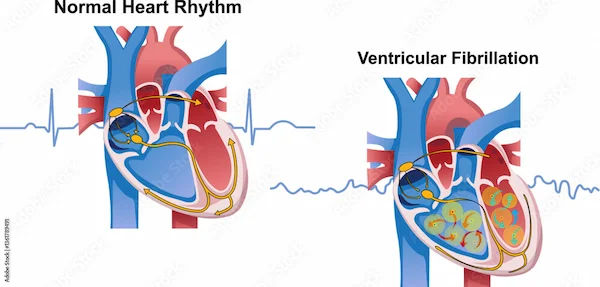Rheumatic Heart Disease in Mitral Valve
Learn about rheumatic heart disease affecting the mitral valve, including its causes, symptoms, treatments, and prevention strategies. Discover how timely diagnosis and lifestyle changes can improve heart health and quality of life.

Written by Dr Sonia Bhatt
Last updated on 3rd Jul, 2025
Rheumatic Heart Disease (RHD) is a chronic heart condition that occurs from poorly treated or
non-treated rheumatic fever. This disease majorly affects the heart valves, the most common being the mitral valve. Damage to this valve can lead to significant disruptions in heart function, affecting overall health and quality of life.
This article covers the causes, symptoms, treatment, and preventive measures for
rheumatic heart disease.
Understanding Rheumatic Heart Disease
The term "rheumatic heart disease" refers to the deterioration of cardiac valves caused by rheumatic fever. Rheumatic fever, resulting from an infection with group A streptococcal bacteria, triggers the immune response, causing inflammation throughout the body, including the heart.
As a result of rheumatic fever inflammation, heart valves may sustain irreversible damage. When the heart valves are damaged, less blood can flow through them or even flow in the wrong direction, leading to several issues. The inflammation primarily targets the heart's valves, leading to damage and thickening of the valve tissue. As time goes by, this damage can cause the mitral valve to become stiff, narrow (stenosis) or develop leaks (regurgitation), which can greatly impair heart function.
The mitral valve, located between the left atrium and the left ventricle, is particularly vulnerable to rheumatic fever. When it's damaged due to rheumatic heart disease, it can result in mitral stenosis (where the valve doesn't open fully) or mitral regurgitation (where blood leaks backwards into the atrium), both of which compromise heart efficiency.
Causes and Risk Factors
Some of the causes of rheumatic heart disease are:
Untreated Infection: Caused by untreated Group A streptococcal infections like strep throat or scarlet fever.
Heart Inflammation: Inflammation affects the heart's inner lining, valves, and muscle, causing damage.
Valvular Damage: The mitral valve is prone to fibrosis and, hence, can be functionally impaired for several years.
Rheumatic fever attacks several times: Recurrent incidents increase the risk of progressive heart valve deterioration.
While these are some of the leading causes of rheumatic heart disease, there are various risk factors that can be identified for a timely intervention.
Untreated or recurrent strep throat infection: Untreated strep throat infection increases the risk of developing rheumatic fever and, consequently, rheumatic heart disease.
Poverty and limited access to healthcare: People from poor regions or communities who have little or no access to healthcare become potential candidates for delayed diagnosis and treatment of streptococcal infections.
Overcrowded living conditions: Overcrowding at malls, slums, or in high-population areas makes for the rapid spread and propagation of streptococcal infections. Thus, there is an eminent outbreak of rheumatic fever.
Family history: Some families have a genetic predisposition toward the susceptibility of rheumatic fever, which then branches out into complications.
Age and gender: Rheumatic fever is mostly seen in kids between 5 and 15 years old. However, the heart issues that follow may stay on and get worse later in life. This disease also targets a majority of women.
Doctors and providers can spot at-risk individuals and health hazards by understanding all these causes and risk factors
Get Personalised Care for Heart Issues
Pathophysiology
The inflammation induced by rheumatic fever may cause enlargement and fusion of the initial rough areas of the mitral valve tissue. Eventually, this scarring can result in structural deformities such as thickened or fused valve flaps (petals), thereby impairing the valve’s proper functioning.
Mitral Valve Stenosis vs. Regurgitation
In the case of mitral valve stenosis, the valve becomes narrow and does not allow enough blood from the left atrium to the left ventricle. This can produce symptoms such as breathlessness and fatigue.
Mitral valve regurgitation is when the valve does not close securely. This leads to blood being thrown back into the left atrium. The result of this can cause an increase in the pressure of the lungs and the creation of irregular heart rhythms.
Symptoms Of Rheumatic Mitral Valve Diseases
Symptoms of rheumatic mitral valve disease can develop gradually or suddenly, depending on the severity of valve damage. Common symptoms include:
Shortness of breath, especially during physical activity or while lying down
Persistent fatigue or weakness
Swelling in the legs, ankles, or abdomen (a condition known as oedema)
Chest pain or discomfort
Palpitations or irregular heart rhythms, such as atrial fibrillation
Anybody experiencing a shortage of breath, chest pains, or swelling for days should immediately consult a health professional. Timely diagnosis and management bring down the probability of a more severe situation and decrease the cases of increased mortality.
Diagnosis
A comprehensive medical history is the first step in diagnosing rheumatic mitral valve disease. Healthcare professionals typically ask about:
Past causes of strep throat or rheumatic fever
Family history of heart conditions
The presence and duration of symptoms
Which Procedures Are Used for Diagnosing Rheumatic Heart Disease?
The health worker can use the following methods to detect or find out the disorder:
Blood test to analyse the inflammatory state or an overactive immune response to identify if the patient has the disease.
An X-ray of the chest to check if there are any signs of heart failure.
An echocardiogram (a heart ultrasound) to see whether the patient has a deficient or a narrow heart valve.
An electrocardiogram (ECG, a heart’s electrical activity test) to check if there are any disturbing rhythms
Get Your Heart Health Checked
Treatment Options
Treatments for rheumatic heart disease may slow the progression of the condition and help manage its symptoms. Some of the featuring treatments include:
Medication: Medical professionals often suggest medication as the foremost remedy for heart failure or an abnormal heartbeat.
Minimally invasive procedure: If a patient’s mitral valve is narrow without other problems, the provider can do valvuloplasty to make the valve bigger.
Surgery: If the patient has severe rheumatic heart disease, heart valve surgery might be the only option left. Under this surgery, a surgeon attempts to repair or replace damaged heart valves. They either fix the valve or replace the damaged valve with an artificial valve or a tissue valve.
In some cases, they may do a Ross procedure, a technique where a surgeon takes out one of the healthy valves and introduces a new valve in its original position or the damaged part.
Prevention Strategies
Preventing rheumatic heart disease starts with addressing the root cause—rheumatic fever. Key steps include:
Prompt treatment of strep throat infections with antibiotics
Educating communities about the importance of early medical intervention
Regular checkups for people with a history of rheumatic fever
Periodic diagnostics tests such as echocardiograms
Lifestyle Modification
Besides combating rheumatic heart disease in the mitral valve by preventive strategies and treatment, incorporating basic lifestyle modifications can also help.
Include plenty of fruits, vegetables, whole grains, and lean proteins
Limit salt intake to control blood pressure
Avoid trans fats and high-cholesterol foods to reduce the risk of heart strain
Engage in moderate-intensity exercises like walking or yoga to maintain cardiovascular health
Manage stress through relaxation techniques, such as meditation or deep breathing exercises
Conclusion
Rheumatic heart disease of the mitral valve can be avoided. However, it has the potential to grow and become a dangerous condition if not treated in time. Early diagnosis, proper treatment, and maintaining a healthy lifestyle may provide a reliably good result. Prevention can be achieved through practising different kinds of food and exercising, which ultimately reduces the risk of complications.
Regular medical check-ups and sticking to the recommended therapies are the most important factors in protecting the heart and improving the quality of life for people suffering from rheumatic mitral valve disease.
Consult Top Cardiologists
Get Personalised Care for Heart Issues

Dr. Tripti Deb
Cardiologist
40 Years • MBBS, MD, DM, FACC, FESC
Hyderabad
Apollo Hospitals Jubilee Hills, Hyderabad

Dr. Bhukya Pavan Kalyan
General Physician
5 Years • MBBS DNB Paediatrics
Bengaluru
PRESTIGE SHANTHINIKETAN - SOCIETY CLINIC, Bengaluru

Dr. Zulkarnain
General Physician
2 Years • MBBS, PGDM, FFM
Bengaluru
PRESTIGE SHANTHINIKETAN - SOCIETY CLINIC, Bengaluru

Dr. Janjirala Seshivardhan
Cardiologist
7 Years • MBBS,DNB(GM),DM(Cardiology)
Manikonda Jagir
Apollo Clinic, Manikonda, Manikonda Jagir

Dr. Anand Ravi
General Physician
2 Years • MBBS
Bengaluru
PRESTIGE SHANTHINIKETAN - SOCIETY CLINIC, Bengaluru
Consult Top Cardiologists

Dr. Tripti Deb
Cardiologist
40 Years • MBBS, MD, DM, FACC, FESC
Hyderabad
Apollo Hospitals Jubilee Hills, Hyderabad

Dr. Bhukya Pavan Kalyan
General Physician
5 Years • MBBS DNB Paediatrics
Bengaluru
PRESTIGE SHANTHINIKETAN - SOCIETY CLINIC, Bengaluru

Dr. Zulkarnain
General Physician
2 Years • MBBS, PGDM, FFM
Bengaluru
PRESTIGE SHANTHINIKETAN - SOCIETY CLINIC, Bengaluru

Dr. Janjirala Seshivardhan
Cardiologist
7 Years • MBBS,DNB(GM),DM(Cardiology)
Manikonda Jagir
Apollo Clinic, Manikonda, Manikonda Jagir

Dr. Anand Ravi
General Physician
2 Years • MBBS
Bengaluru
PRESTIGE SHANTHINIKETAN - SOCIETY CLINIC, Bengaluru


